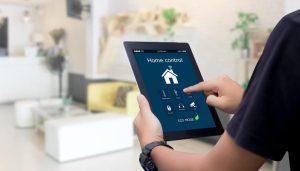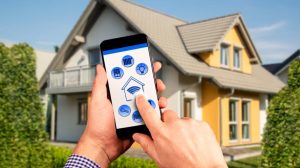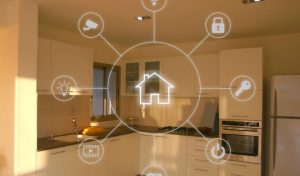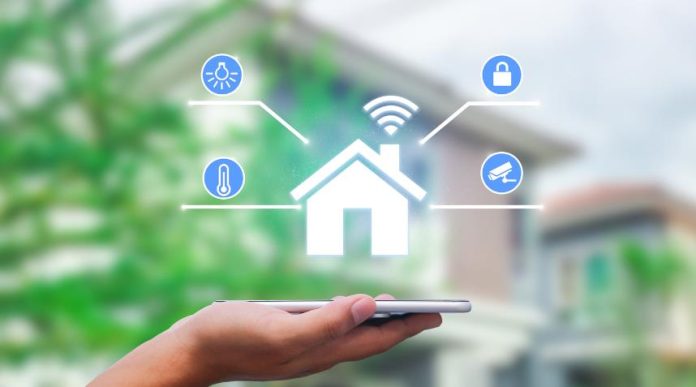Table of Contents
In today’s fast-paced, technology-driven world, the concept of a ‘smart home’ has moved from being a futuristic idea to a present-day reality. The term ‘smart home’ might sound like something straight out of a science fiction novel, but it’s a simple and increasingly common aspect of modern living. But what is a smart home? Let’s delve into the details.
What exactly is a smart home?
A smart home is a highly automated dwelling connected to the internet. It’s an ecosystem of interconnected devices that can communicate with each other seamlessly, making your life easier and more comfortable. These devices range from lighting, temperature control, security systems, entertainment systems, kitchen appliances, etc. Smart homes are all about convenience and automation, where you can control almost everything with your voice, smartphone, or a smart assistant like Alexa or Google Home.

Smart Homes work through connected devices in which all devices are connected to a central hub or a mobile app that communicates with these devices using Wi-Fi. This means that we can control and customize the features of our home through our mobile devices from anywhere. For instance, we can regulate our home temperature through our mobile phones, which will turn on the air conditioning unit or heating system accordingly. Similarly, smart homes allow us to control our home lighting, locks, and kitchen appliances through our mobile phones.
Understanding Smart Home Automation
Smart home automation uses various interconnected devices that can communicate with each other and be controlled remotely to automate household functions. This might include controlling lighting, adjusting temperature, managing security systems, and even operating appliances. The goal is to make life more convenient, comfortable, efficient, and secure.
How does this all work? The underlying mechanisms of smart home automation revolve around connectivity, centralized control, and automation.
Connectivity: The Foundation
The foundation of smart home automation is connectivity. This involves equipping home devices and appliances with technologies that allow them to connect and communicate with each other and the internet. Most smart devices connect using Wi-Fi, but other technologies like Bluetooth, Zigbee, or Z-Wave can also be used.
Each smart device in a home is embedded with sensors and chips, which allow them to send and receive data. For example, a smart thermostat can sense temperature changes, a smart door lock can detect when it’s being unlocked, and a smart light can know when to turn on or off based on ambient light levels.
Centralized Control: The Brain
Once devices are connected, they need to be controlled. This is where a central hub, often called a gateway, comes in. The hub serves as the smart home’s brain, receiving information from different devices, processing it, and sending commands.

Imagine you have a routine where your lights dim, your thermostat lowers the temperature, and your blinds close at 10 PM every night. You don’t command each device individually; instead, you set up this routine on the central hub. The hub sends commands to each device at the specified time to carry out its routine.
The hub can be a standalone device, like Samsung’s SmartThings Hub, or a feature built into another device, like Amazon’s Echo or Google’s Nest.
User Interface: The Command Center
The user interface is how you interact with your smart home system. This could be a smartphone app, a web portal on your computer, or a voice assistant like Amazon Alexa or Google Assistant.
This interface allows you to control individual devices, create routines, set schedules, and even monitor your home. For instance, you could set your coffee maker to start brewing coffee when your morning alarm goes off or have your lights turn off automatically when everyone leaves the house.
Automation: The Magic
The real magic of smart home automation lies in its ability to perform tasks automatically. This means that devices can perform certain actions based on predefined conditions without manual intervention.
For example, you could have your doors lock themselves automatically when you leave the house, or your lights could turn on by themselves when you walk into a room. This level of automation makes life more convenient and helps save energy and increase security.
The Role of Artificial Intelligence (AI)
AI plays a crucial role in smart home automation. Many smart devices use AI to learn from your behaviors and patterns over time and make decisions accordingly. For example, a smart thermostat can learn your schedule and adjust the temperature in your home based on when you’re usually there and when you’re not.
Interoperability: The Key to a Truly Smart Home

For a smart home to function smoothly, it’s essential that all the smart devices can work together, regardless of their manufacturer. This is known as interoperability. Thanks to protocols like Zigbee, Z-Wave and platforms like Apple’s HomeKit, Google’s Home, and Amazon’s Alexa, interoperability is becoming more common, allowing devices from different manufacturers to work together seamlessly.
Benefits of Smart Home
Convenience
One of the most notable benefits of a smart home is its sheer convenience. With a smart home, you can control various devices and systems in your home remotely. Whether it’s adjusting the thermostat, turning off lights, or checking if all doors are locked, all these tasks can be done from anywhere using your smartphone or computer. You no longer need to worry about forgetting to turn off an appliance or wondering if you locked the front door.
Enhanced Comfort
Smart homes significantly enhance comfort. For instance, with a smart thermostat, you can program your home’s heating and cooling system to maintain the perfect temperature throughout the day. Similarly, smart lighting systems can adjust the lighting based on the time of day or your personal preferences, creating the ideal ambiance for any situation.
Improved Security

Security is a crucial aspect of any home, and smart homes take security to a whole new level. From smart locks and security cameras to alarm systems and smoke detectors, smart homes offer a robust security framework that can be monitored and controlled remotely. You can receive alerts on your phone when a security camera detects movement or when a door or window is opened. This enhanced security gives homeowners peace of mind, knowing their home is protected round-the-clock.
Energy Efficiency
Smart homes are synonymous with energy efficiency. Smart devices like thermostats, lights, and appliances can operate in energy-saving modes when not needed, reducing energy consumption. For instance, a smart thermostat can learn your schedule and adjust the temperature accordingly, ensuring energy isn’t wasted when no one is home. Similarly, smart lights can automatically turn off when a room is unoccupied. This efficiency helps conserve energy and results in significant cost savings.
Increased Property Value
With the growing popularity of smart technology, having a fully integrated smart home can increase the value of your property. Prospective buyers are willing to pay a premium for homes with smart features due to their numerous benefits.
Career Development In The Field Of Smart Homes
The field of smart homes is a rapidly growing industry, creating a wealth of career opportunities for individuals with varying skill sets.

Here are some potential paths for career development in this exciting field:
- Smart Home Consultant: As a consultant, you would assist homeowners in choosing the right smart home solutions to fit their needs and lifestyle. This role requires a deep knowledge of the different smart home technologies available and how they can work together.
- System Integrator: System integrators ensure different smart home devices can communicate with each other effectively, creating a seamless user experience. This role requires a strong background in computer networking and software engineering.
- Software Developer: Software developers create the applications that homeowners use to control their smart home devices. This role requires coding, user interface design, and sometimes machine learning skills.
- Product Designer: Product designers work on the physical design of smart home devices. This role requires skills in industrial design, user experience, and an understanding of manufacturing processes.
Conclusion
As technology advances, smart home automation will become more sophisticated, making our homes not just places to live but intelligent entities that anticipate our needs and simplify our lives. To develop a career in the smart home industry, it’s important to stay updated with the latest technology trends and continually enhance your skills. Consider obtaining certifications related to smart home technologies and participating in relevant training programs.


